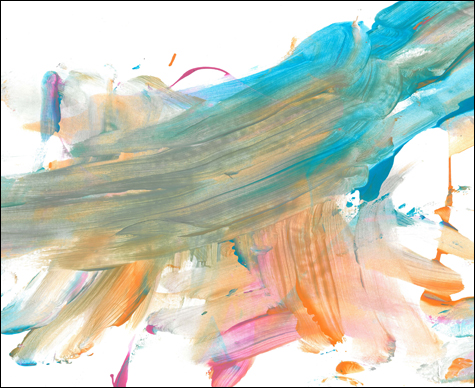
|
“Okie and Little Joe: A Retrospective”
Franklin Park Zoo | 1 Franklin Park Road, Boston | Through September 14 |
The gorilla is a black blur, out of nowhere, barreling into the cage door — clang! — and then zooming off through the fake rocks and trees. It scares the bejesus out of me. Zookeeper Brandi Moores says the artistically inclined ape who goes by the name Okie was cranky about not having been fed yet that morning. But I can’t help taking it personally. Okie seems to be telling me, “Stay the fuck away!”It’s an hour before opening time inside the Franklin Park Zoo’s sweaty Tropical Rainforest building. For three years, Moores has been helping Okie make fingerpaintings. Seven of the gorilla’s works — along with one by his companion Little Joe — are on exhibit in the Rainforest house through September 14. I’ve come to see him in action. There is much art these days about the nature of art and being an artist, but how often do you get the chance to examine the artist’s paintings behind glass and then study the artist himself behind glass?

Dressed in ranger garb and with her brown hair pulled back into a practical ponytail, Moores carries paper and a box of non-toxic children’s paint into a little room beside the gorilla exhibit. I watch warily as she opens a metal door, a sort of airlock between people freedom and gorilla prison, and reveals a heavy metal mesh door behind it. She sits cross-legged on the floor as Okie squats just on the other side. He’s 14, and his black hair is turning gray across his broad strong back, the distinctive coloring that gives adult male gorillas the name “silverback.”
Moores squirts paint out onto paper and slides it under the gate. Okie works from a squat, with one hand, and sometimes a foot, clutching the door’s mesh. His artistic technique is quick and nonchalant. He smears the paint around with his knuckles, maybe adds some fingerprints, or eats some of the pigment. Much of the time he looks elsewhere, seemingly ignoring his work. (Moores says this apparent indifference is unusual and probably a sign of stage fright.) After a minute or two, Moores slides the paper back out under the gate and rewards Okie with grapes or a slice of orange. The painting is a mess of juicy, brightly colored smears.
What is it that so intrigues us about the growing body of art made by apes, elephants, and dogs? We are looking for what distinguishes us from the rest of life on Earth. We crave some common language that will allow us to bridge the evolutionary gap that separates us from our critter cousins. Maybe animal art holds clues to where people art originated. And, of course, it amuses us as a circus stunt.
Back in the early ’80s, David Gucwa noticed that an elephant he cared for at a zoo in Syracuse was using pebbles to scratch designs into the floor of her cage when alone at night. It turned out that captive elephants commonly use sticks or stones to doodle. He helped her switch to pencil on paper and sent the drawings — simple abstract scribbles — out to various art and animal experts for comment. In his 1985 book To Whom It May Concern: An Investigation of the Art of Elephants, he reports mailing a package to the abstract expressionist Willem de Kooning. The artist’s painter wife, Elaine, wrote back: “When Mr. de Kooning and I received your package, before we read your letter, we looked at the drawings and were very impressed by them. We felt they had a kind of flair and decisiveness and originality. Needless to say, we were dumfounded when we read that they were made by an elephant. Mr. de Kooning said, ‘That’s a damned talented elephant.’ ”
But Gucwa’s elephant is no artistic competition for the painter elephants whose work is sold in a project that conceptual artists Vitaly Komar and Alexander Melamid have organized to raise funds to care for domesticated and wild elephants — while also raising questions about what it means to be an artist. (Video documenting the elephant artists was exhibited at the DeCordova Museum in Lincoln last fall.) Elephants’ trunks seem especially suited to making the flowing arrangements of lines that recall de Kooning’s late lyrical, open abstractions.
Some of the Komar/Melamid elephants have been trained to paint flowers in the loose style of traditional Chinese paintings. It may just be that the flower-painting elephants have learned to mimic a pattern — a feat in itself, but distinct from the art of depiction. What is the animal artists’ intent? Are they simply exercising fine motor skills? Or is it an effort at original communication, a coded message from the animal world?